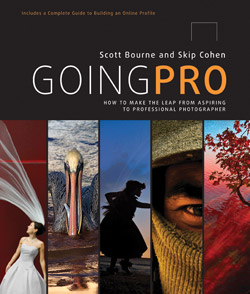GOING PRO: How To Make The Leap From Aspiring To Professional Photographer

© Jeremy Cowart
Written by Scott Bourne, known as the “king of social media” and the #1 most influential photographer on Twitter, according to wefollow.com, and Skip Cohen, former president of Rangefinder Publishing—GOING PRO offers practical advice on such fundamentals as defining your niche, putting together a portfolio, pricing and showing your work, marketing, and positioning your brand. The book offers a complete guide to using social media to build an online presence from the ground up, including Twitter, Facebook, blogs, podcasts, and webinars. Throughout, advice and tips are offered from leading pros in the field.
To give you an example of the many great tips in the book we thought we’d share part of their chapter on using Twitter.—Editor

© Matthew Jordan Smith
Start Using Twitter
Before you start using your Twitter account to grow your photo business, consider the following: What are your goals and objectives? Who is your audience? What sort of content can you regularly provide? What sort of brand will you represent? How often will you use Twitter to market yourself? Can you be a part of a community, and if so, which one? What style and voice will you bring to the table? Consider the outcome of your Twitter marketing plan. Use this as a roadmap to success.
When choosing a name for your Twitter account, use one that is professional: for example, “George Jones Photographers,” not “BabyGotBack199.” Your Twitter name is the first contact potential clients have with you. Make it count. Once you’ve come up with a name, go to www.namechk.com to see if it is available for use on other social media sites. If you plan to expand beyond Twitter, it’s helpful to use the same name in all places. It might be the right move to use your business name as your Twitter name, but never forget that people are hoping to interact with you as a person, not just a business.
Now you are ready to go to www.twitter.com and set up your free account. Fill out your Twitter profile and include your contact info. Make sure you use the word “photo” or “photography” or “photographer” in your profile and include a picture of yourself. From our unofficial Twitter tests, we’ve found that a photo on your homepage is very effective; in most cases, a photo of you is much better than one of your logo, for example. If you really want to stand out, create a custom Twitter background that offers even more information about yourself. (Search “custom twitter background” on Google for more information.) Be sure to revisit your Twitter profile every three to six months to make sure it is up to date.
We recommend that when you start using Twitter for business, you remove most of your personal opinions about controversial subjects from your profile. People who follow you for photography advice don’t really care about your politics. If you talk about religion or politics, you will lose some portion of your audience, no matter how valuable your photo-related content might be.
Set up Twitter so you can monitorit on the go. Visit http://m.twitter.com to set up mobile Twitter access. If you have an iPhone, Twitter has an iPhone-specific application you can use.
Now, take the following steps in the following order:
Follow. Find photographers you admire, industry leaders, well-known instructors, and photo vendors to see how they use Twitter. Go to www.wefollow.com and search the categories “photography,” “photographer,”and “photo.” While you’re at it, add yourself to the WeFollow directory in the same categories. Follow your clients if they are on Twitter. You may also want to follow your friends and family, although using a Twitter account for business and to interact with friends and family may become awkward. Follow only people you know or know of. This advice goes counter to what some of the so-called “social media experts” will tell you, but we’ve seen the negative results that can result from following the wrong people on Twitter. It’s all about association. With whom do you want to be seen associating?

© Kevin Kubota
Listen. Just listen. See what other photographers are saying. Search photo-related tweets using Twitter’s search function (http://search.twitter.com). Make sure you’re also monitoring corresponding Google alerts (www.google.com/alerts).
Set goals. After you listen and get the basic idea of how Twitter can work, decide what goals you want to pursue. Do you want to find new prospects, sell photos, offer customer support, find new clients, or gain new sponsors?
Establish credibility. Start by re-tweeting authoritative content. Be a part of the conversation. When someone has a question you can answer, answer it. If you see a cool photo blog or product or photo, tweet about it and link to it.
Tweet daily. If you’ve followed the aforementioned steps, you probably have a pretty good idea of how you can use Twitter to send out your own messages. Send one tweet a day for the first week and see how that’s received. Judge the reaction, adjust as necessary, and tweet once per day for a second week. Repeat the cycle until you’re comfortable with the results, and then cut loose. But always remember to think before you tweet. Once you press the ENTER key, the words you just wrote will live forever in the Internet universe.
Engage. Answer questions, offer links, and be responsive and helpful.

© Michael Corsentino
Tweet Now
Before you get overwhelmed, we want to remind you that Twitter can be useful to you right now. We’re going to give you additional Twitter knowledge in the next few pages, but first, here are five things you can do immediately to grow your budding photography business:
• Tweet a link to your portfolio and ask for feedback.
• Tweet a link to a recent photo shoot or event or image that you were paid for.
• Tweet a link to a contest offering a free print or session in your studio.
• Use search.twitter.com to find prospects by searching for related topics, such as weddings for wedding photographers.
• Send a tweet answering someone’s photography questions.
How Twitter Can Help Your Business
Here are just a few ways photographers can use Twitter to advance their business:
To replace e-mail. Your followers can send you messages at least as fast, if not faster, via Twitter than they can via e-mail. Another plus: Twitter is a persistent link (meaning your contact info is not going to change, as an e-mail address can), which makes Twitter more valuable than e-mail for a number of reasons, including SEO.
To replace Really Simple Syndication (RSS). No offense to Dave Winer, creator of the RSS feed, but RSS is a bit outdated in terms of efficiency. We continue to have RSS feeds on our blogs and podcasts, but we notice that significantly fewer people rely on these feeds to notify them of new blog posts compared with those who ask us to let them know via Twitter. When we post something new to the RSS feed and to Twitter at the same time, the Twitter audience is usually hitting the site more actively than the RSS audience.
To provide direct links to photographs. Showing one’s work is a photographer’s most basic marketing activity, and some are building followings simply by linking to a photo every day.
To create effective contests and giveaways. Contests draw followers but don’t keep them. You keep followers by sharing real, free, valuable information, such as photography tips or news about new gear or firmware updates, contests, shows, free tutorials, podcasts, and blog posts.
To send, receive, and read tweets on a smartphone. Twitter is mobile, and many users experience it on their cell phones. This means you don’t have to wait for people to be tied to their computers to communicate with them. That additional lifeline in the communication chain can be the difference between making a photo sale or not.
To search out tweets from photographers you admire and RT (re-tweet) them to your network. Re-tweeting is a great way to share information and provides a possible link between you and new content. It also shows you care about the community and may lead to alliances you never had an opportunity to create via other media.
To talk about current assignments and post links to photos. Wedding photographers might talk about the bride they’re currently working with. Workshop leaders might talk about the location they’re visiting. This may leverage your skill in interesting ways, such as offers to do books, workshops, symposiums, or seminars.
To hire. If you need an assistant, receptionist, or retoucher, Twitter is a great place to get the word out. It’s fast, free, and viral. Particularly in the current economy, where jobs are scarce, people will RT (re-tweet) job postings. We’ve had hundreds of responses to one simple tweet about a part-time job opening. It works.
For researching. Skimming for photo-related links, news, and reviews is easy now that Twitter has a search tool. And since Twitter is in real time, you can bet that if you’re following the right people, you’ll probably find out about the next new Nikon or Canon camera body on Twitter before you hear about it anywhere else. You can also use Twitter to poll other photographers for advice, see what they are working on, and ask what tools and techniques they are using.
As an education tool. Many photographers use Twitter to share tips, whether it’s how to get the most out of a lens, how to book models in return for prints, or how to select a lens. Try to be generous with free tips. Let newbies benefit from your experience by answering their questions via Twitter. This makes you a welcome part of the Twitter community.
For networking. By paying close attention to Twitter, you can discern the relationships among certain photographers, vendors, and photo associations and their audiences. You can find out who knows who and perhaps establish a connection to someone you know. Twitter proves the old “six degrees of separation” theory pretty well. If you look at someone’s stream on Twitter, it won’t be long before you know someone who knows that person.
About The Authors
SCOTT BOURNE is president and founder of Bourne Media Group, publisher of Photofocus.com, and the #1 most influential photographer on Twitter, according to wefollow.com. His images have received more than 100 awards, and he has led more than 150 workshops and seminars worldwide. Scott is co-founder of the Professional Wedding & Studio Photographers International (PWSPI) and GoingPro2011.com. Scott can be found at Photofocus.com.
SKIP COHEN is president of Marketing Essentials International, a consulting firm specializing in photography projects. He is past president of Rangefinder Publishing Inc., where he oversaw Rangefinder and AfterCapture magazines, the Wedding & Portrait Photographers International (WPPI) Association, and the WPPI tradeshow. He is founder of Skip’s Summer School and the Akron Photo Series, and co-founder of GhostRighters.com, GoingPro2011.com, and PWSPI. Skip has co-authored five previous books on photography and can be found at SkipsPhotoNetwork.com.
The GOING PRO blog (www.goingpro2011.com) and podcast series are seen and heard by hundreds of thousands of photographers each month, and is to be joined by a touring road show.

GOING PRO: How to Make the Leap from Aspiring to Professional Photographer by Scott Bourne and Skip Cohen
Amphoto Books
ISBN: 978-0-8174-3579-0
• 240 pages
• $29.99
• Paperback

















































